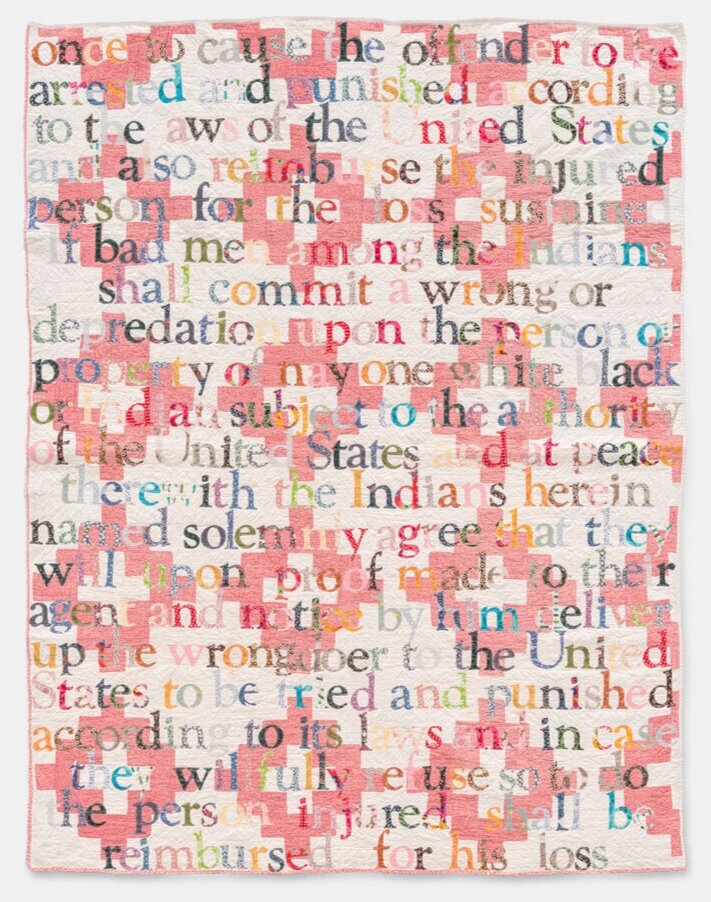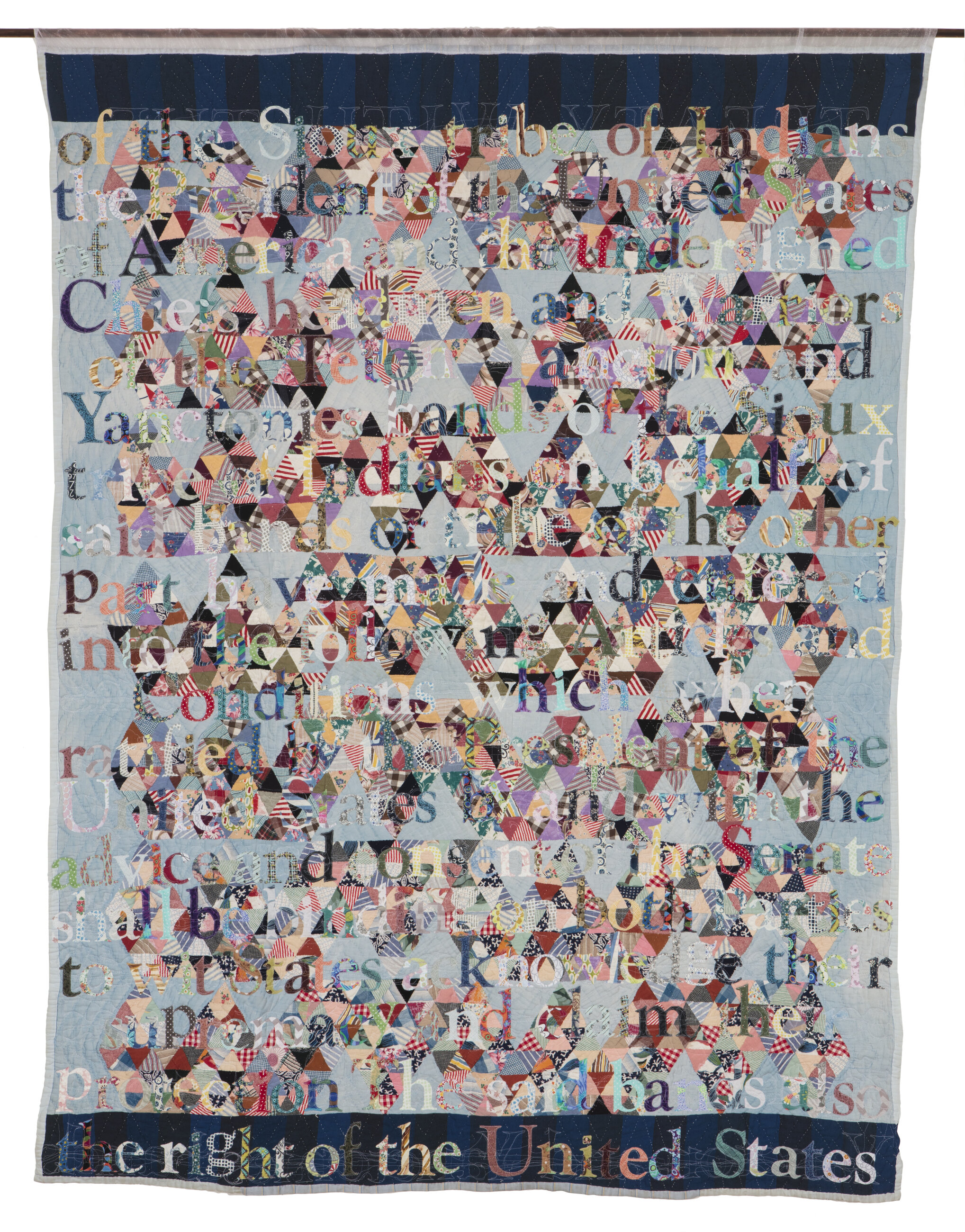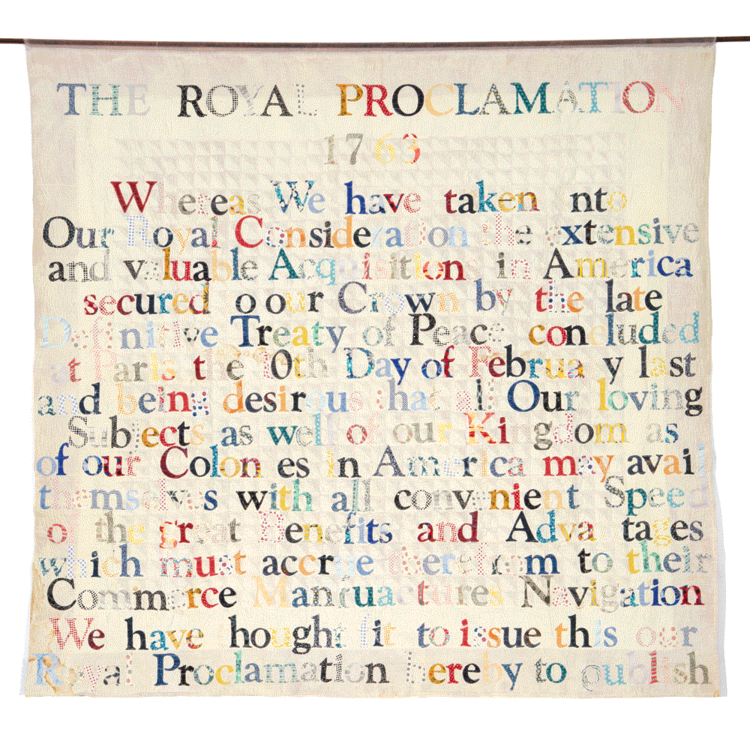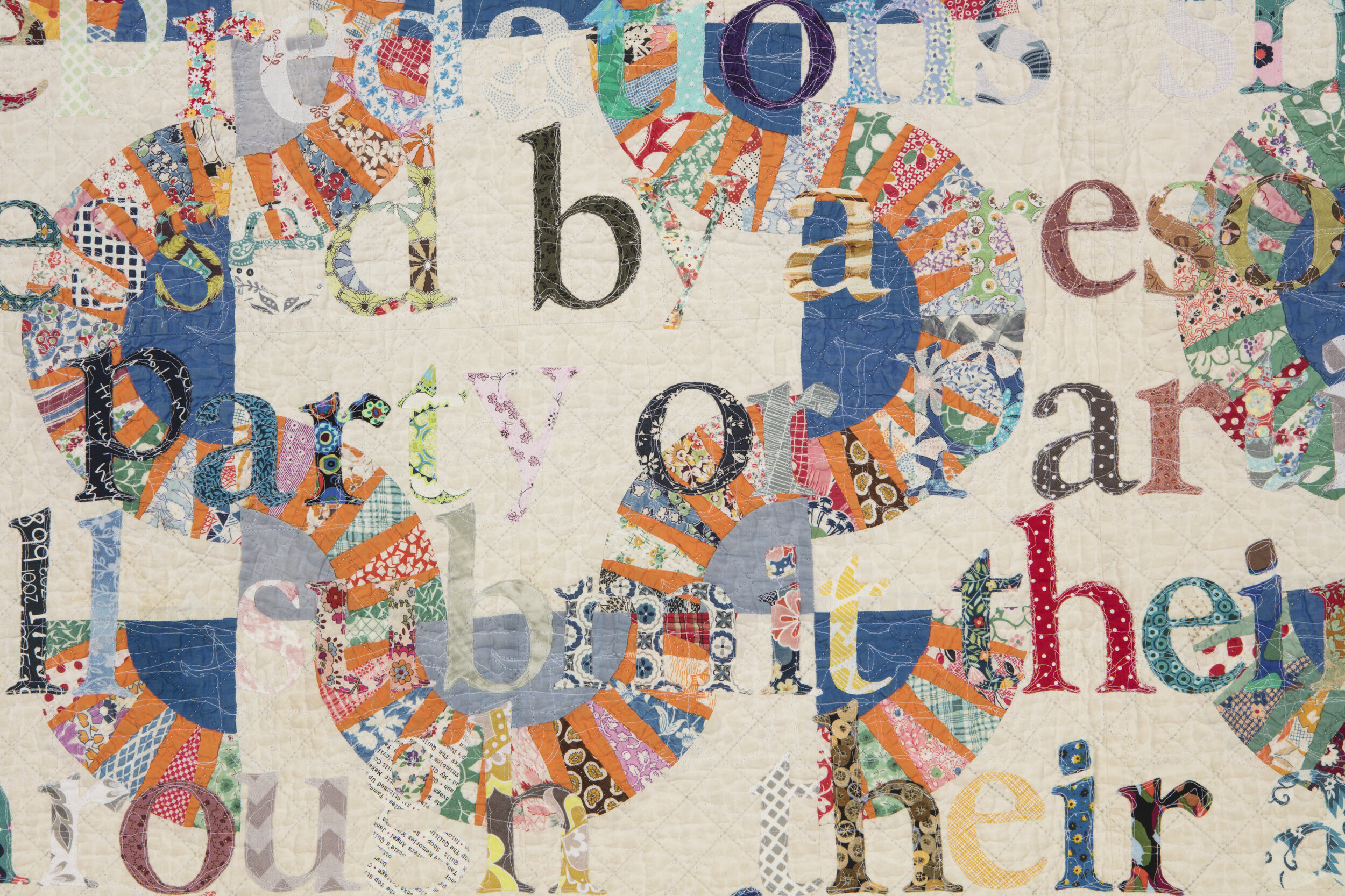Gina Adams’ cross-media, hybrid studio work includes sculpture, ceramics, painting, printmaking, drawing and large scale quilts which combine the reuse of antique quilts which she restructures to include words from broken treaties between the United States and Native American tribes. Adams draws on cultural practices passed down from her ancestors as well as from family history of forced assimilation. She is a descendant of both indigenous (Ojibwe) and colonial Americans.
Adams spent her early youth in the San Francisco Bay area, and then her adolescent and early adult years in Maine. Her formal education includes a BFA from the Maine College of Art and MFA from the University of Kansas, where she focused on Visual Art, Curatorial Practice and Critical Theory. She currently holds a tenure track Assistant Professor position at Emily Carr University of Art & Design in Vancouver, British Columbia.
Her work has been exhibited extensively throughout the US and resides in many public and private collections including Portland Museum of Art; University of Kansas, Lawrence, KS; Emprise Bank, Wichita, KS; Nerman Museum of Contemporary Art, Kansas City, MI; Spencer Museum of Art, Lawrence, KS; North American Native Museum, Zurich, Switzerland; Great Plains Museum, Lincoln, NE; and the Museum of Contemporary Native Arts, Santa Fe, NM. In recent years Adams' work has been featured in publications including The New Yorker, Hyperallergic, The New York Times, Huffington Post and Art Newspaper among others. Adams is represented by Accola Griefen Fine Art in New York City.
For more information, please see: ginaadamsartist.com, Accola Griefen Fine Art, and on Instagram @ginaadamsartist.
Gina Adams, Treaty of Fort Laramie 1868 (front), 2014. Hand cut calico letters on antique quilt 83.5”H x 63.25”W. Image courtesy of the Artist and Accola Griefen Fine Art.
Gina Adams, Treaty of Fort Laramie 1868 (back), 2014. Hand cut calico letters on antique quilt 83.5”H x 63.25”W. Image courtesy of the Artist and Accola Griefen Fine Art.
First, and most importantly, how are you doing? How are you navigating the highs and lows?
Each day I wake and I ask the question “what can I do that is giving today?”. It’s the practice that keeps me out of feeling like there is no control with the covid-19 pandemic and the feeling of deep isolation that comes with being quarantined for over eight months in Canada. I follow my morning routine with a cup of tea and then meditate for thirty or so minutes. I also listen to mindfulness meditations. Right now, I am loving Michael Beckwith on mindvalley.com. Then I work in the studio for the day while listening to podcasts. I try to stay balanced and consistent, and if I find the lows are appearing then I will meditate again and listen to another Michael Beckwith segment. In the afternoon, I take a break from the studio to read and do research. If I have dedicated research or writing I need to work on I usually do that in the mornings.
Gina Adams, Louisiana Purchase (front), 2019. Hand cut calico letters on antique quilt. 71”H x 90”W. Image courtesy of the Artist and Accola Griefen Fine Art.
Gina Adams, Louisiana Purchase (back), 2019. Hand cut calico letters on antique quilt. 71”H x 90”W. Image courtesy of the Artist and Accola Griefen Fine Art.
It's my experience that most artists engage with some level of self-isolation in their day to day art practice. Has this been your experience? And if so, have you found these innate rhythms to be helpful during this larger, world-wide experience of isolation?
I feel very fortunate to be an artist during this time. I have always found that my studio process required self-isolation: Being alone and working on my ideas and processes is a gift and I love it. For the most part the studio has not slowed down during this time, and instead, my ideas have expanded into new future projects and collaborations with new materials. Before graduate school my studio was always a separate building from where I lived and I would drive between 15 and 30 minutes to get to it. Post graduate school, I have found that I work best if the studio is connected to my home or on my property. In Colorado for instance, my studio portion of my house was 2/3rds of it. The only separation was the bedroom and the kitchen and bathrooms. All other rooms were where I worked on a daily basis, and I had areas dedicated to the different mediums for which I work in. Since moving to Vancouver and accepting a tenure track position at Emily Carr University of Art & Design my studio situation has changed - being that I do have a studio that is attached to my apartment, but it’s a separate space from my living. It’s also mostly an office and then a large studio space dedicated to working on Broken Treaty Quilts, drawing and painting. All encaustic and ceramic work must be done outside my studio and will eventually be done in the studios of Emily Carr once our campus reopens and we are no longer teaching online and social distancing.
Gina Adams, Treaty of Fort Laramie, 1851 (front), 2017. Hand cut calico letters on antique quilt. 74”H x 72”W. Image courtesy of the Artist and Accola Griefen Fine Art.
Gina Adams, Treaty of Fort Laramie, 1851 (back), 2017. Hand cut calico letters on antique quilt. 74”H x 72”W. Image courtesy of the Artist and Accola Griefen Fine Art.
It would be great if you could briefly talk us through your practice. Understanding it is integral to appreciating the multivalence of your work.
I am fascinated by stories passed down, both from my own familiar heritage and those told by others. I believe that the passing down of memories is what keeps our genetic heritage alive. I am interested in, and seek out others, who have a similar story to tell, and I immerse myself in their shadows. I do so in order to tell my story more clearly, and doing so helps to clarify what I want the work to say visually.
There is a connection to what the ancient ones taught my ancestors, as this information was passed down generation to generation. I consider my work a spiritual endeavor in which the process of making is a ritual. I decided to learn how to make objects in order to have a better understanding of my ancestors and how I am similar to them. The process of making imbues my identity with an ancestral connection to the sacred and the ritual object.
In storytelling I am moved by a sense of discovery and connection, much of it deeply rooted in place and land. My life's journey is about where the land, peoples, and stories come together. It is my wish that the viewer will add their own experience to my work. Thank you for taking the time for your own discovery, as it brings meaning to the day. Miigwetch/Thank you.
I would also like to refer you to this article/interview as it truly touches upon so much of my artistic journey and practice.
Gina Adams, Treaty with the Teton (front), 2019. Hand cut calico letters on antique quilt. 68”H x 87”W. Image courtesy of the Artist and Accola Griefen Fine Art.
Gina Adams, Treaty with the Teton (back), 2019. Hand cut calico letters on antique quilt. 68”H x 87”W. Image courtesy of the Artist and Accola Griefen Fine Art.
Gina Adams, Treaty with the Teton (detail), 2019. Hand cut calico letters on antique quilt. 68”H x 87”W. Image courtesy of the Artist and Accola Griefen Fine Art.
Has any of your imagery shifted in a reflection to what's currently happening? And why, or why not?
My imagery has shifted dramatically since moving to BC and being in a different country and on the lands of the Musquiem, Squamish, and Sawelatooth. This land is unceded meaning that there has never been a treaty governing the land and it is still considered to belonging to the indigenous people. This land is giving and the more time you spend on it the more it opens up. My dreams have been vivid, involving eagles, bears, salmon, and seals, and I am often floating in the waves that are colored a vivid sky-blue. There is a warmth to the color that is quite different from the reality of the glacier fed rivers that are not as easy to swim in due to their very cold tempurature. I am originally from Maine, and have been used to swimming in very cold water…. this is much colder, but also healing for its rich mineral content. I am working up to a full swim; for now I walk and wade in the shallows and I am content to immerse myself in the beauty of the landscape.
I have had time right now to reintroduce myself to imagery that I have not had time for before now. Imagery from drawings that I created while immersing myself in museums collections of belonging. I am creating new bodies of artwork with these ideas that are exciting to me. I want to keep them to myself for a while and let my ideas flow between the imagery, the mark making, the dreams that come in the process of working in the studio.
Gina Adams, Treaty of Fort Wise (front), 2019. Hand cut calico letters on antique quilt. 71”H x 76”W. Image courtesy of the Artist and Accola Griefen Fine Art.
Gina Adams, Treaty of Fort Wise (back), 2019. Hand cut calico letters on antique quilt. 71”H x 76”W. Image courtesy of the Artist and Accola Griefen Fine Art.
Are you thinking differently? Coping differently? Inspired differently?
My day revolves around thinking about how I can connect while being disconnected. This is not unlike some of the feelings of disconnection that are related to my inherited trauma. I am choosing to process my time with my Ojibwa language and connecting virtually with relatives and friends who share histories.
Gina Adams, Royal Proclamation of Canada (front), 2017. Hand cut calico letters on antique quilt. 77”H x 84”W. Image courtesy of the Artist and Accola Griefen Fine Art.
Gina Adams, Royal Proclamation of Canada (back), 2017. Hand cut calico letters on antique quilt. 77”H x 84”W. Image courtesy of the Artist and Accola Griefen Fine Art.
What is bringing you solace, or even joy, in this moment?
I love to cook, and usually love to support local farmers in my community. It’s been harder to do this with fresh veggies during the pandemic due to the number of people that live in Vancouver and the organized farmers markets that are trying to figure out social distancing covid times. We were turned away several times as the lines were looking like hours to get into the markets. This past weekend, after much scouting and failed attempts at different markets we finally found one that we were able to access. I spent the day making pickles and processing kale for the freezer. If I didn’t live in an apartment and if I had access to growing space, I would have my own garden. This is my next thing to figure out. It’s becoming a real necessity to have your own growing space and I want mine to be organic.
Gina Adams, Treaty with the Kiowa Comanche and Apache (Three Medicine Lodge), 1867 (front), 2015. Hand cut calico letters on antique quilt. 96”H x 71”W. Image courtesy of the Artist and Accola Griefen Fine Art.
Gina Adams, Treaty with the Kiowa Comanche and Apache (Three Medicine Lodge), 1867 (back), 2015. Hand cut calico letters on antique quilt. 96”H x 71”W. Image courtesy of the Artist and Accola Griefen Fine Art.
What research or writing are you doing that you find compelling?
I am doing research currently that is a continuation of my Smithsonian SARF fellowship and from the objects of belonging. Mostly I am looking at objects that were made of wood and considering other similar objects from the same time period. These objects were used domestically and with serving meals. In this I am considering how the change from being matrilineal to patrilineal with the US governnment’s forcing of the Native American men in signing the treaties. Their making the decision for their people should not have happened the way it was forced to and doing so changed their way within their communities forever.
In September, I started cutting new letters of three treaties: The Treaty of Chicago 1821 and 1833, and The Treaty of New Echota 1835. Research for this process starts by finding all evidence and scholarly writing on each treaty that I can find through online sources. Then I look for images of original maps documenting the land before and after the treaties are signed. I also look to see if there are corresponding peace treaty medals in any collections that correspond with the treaties.
Gina Adams, Treaty of Little Arkansas (front), 2019. Hand cut calico letters on antique quilt. 68”H x 92”W. Image courtesy of the Artist and Accola Griefen Fine Art.
Gina Adams, Treaty of Little Arkansas (back), 2019. Hand cut calico letters on antique quilt. 68”H x 92”W. Image courtesy of the Artist and Accola Griefen Fine Art.
Are you reading anything?
I always have about a dozen books that I am reading at one time. Right now, they consist of:
· Mastering Hand Building by Sunshine Cobb
· Possibilizing the Impossible: Equity in Postsecondary Arts Institutes by Ashok Mathur & Rita Wong
· Me and White Supemacy by Layla F. Saad
· Braiding Sweetgrass by Robin Wall Kimmerer
· Sacred Instructions by Sherri Mitchell
· Indian Artists At Work by Uli Steltzer
· Revision and Resistance Kent Monkman
· Vision, Space, Desire: Global Perspectives and Cultural Hybridity, NMAI Editions
· Giving Voice to Bear by David Rockwell
· The Everlasting Sky, Voices of the Anishinabe People by Gerald Vizenor
· Beau Dick Revolutionary Spirit by Darrin J. Martens
· Grandmothers Counsel the World by Carol Schaefer forward by Winona LaDuke
· Fire in the Village, New and Selected Stories by Anne M. Dunn
· Voices from Haskell, Indian Students Between Two Worlds, 1884-1928 by Myriam Vučković
· Art in Action, Nature, Creativity and our Collective Future from the Natural World Museum
· Low-Fire Soda by Justin Rothshank
· Slow Stitch Mindful and contemplative textile art by Claire Wellesley-Smith
Gina Adams, Treaty of Little Arkansas (detail), 2019. Hand cut calico letters on antique quilt. 68”H x 92”W. Image courtesy of the Artist and Accola Griefen Fine Art.


















